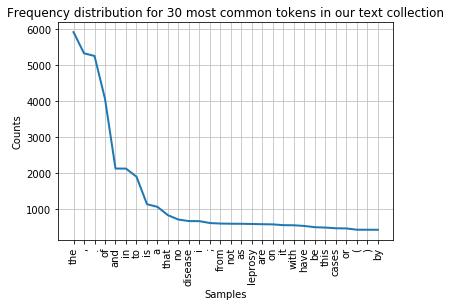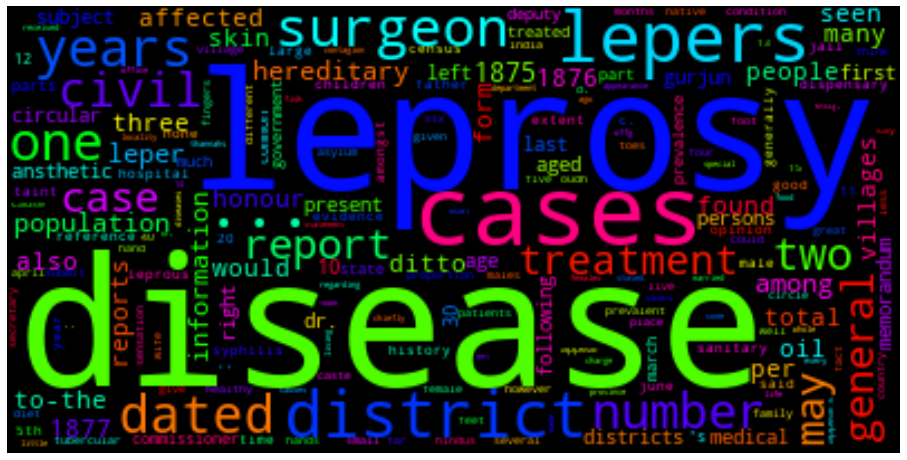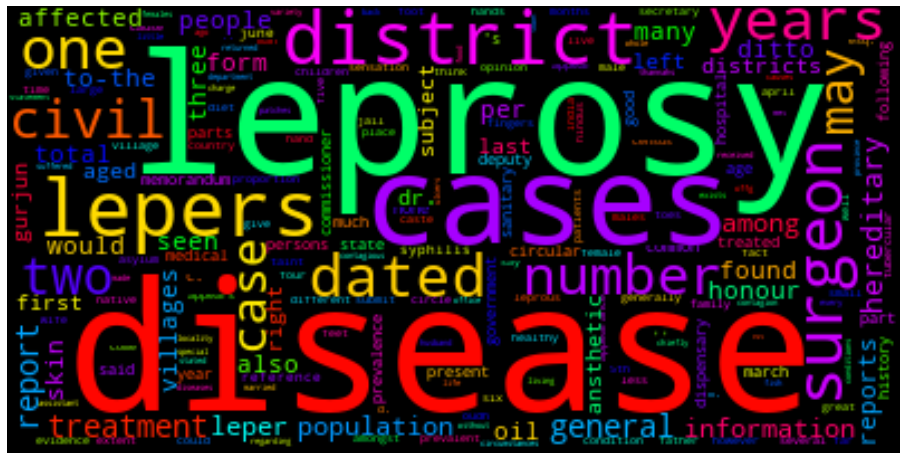Textmining
Visualising Frequency Distributions of Tokens in Text
Keypoints:
- A frequency distribution can be created using the
plot()method. - We can clean data by removing stopwords and other types of tokens from the text.
- A word cloud can be used to visualise tokens in text and their frequency in a different way.
Graph
The plot() method can be called to draw the frequency distribution as a graph for the most common tokens in the text.
fdist.plot(30,title='Frequency distribution for 30 most common tokens in our text collection')

You can see that the distribution contains a lot of non-content words like “the”, “of”, “and” etc. (we call these stop words) and punctuation. We can remove them before drawing the graph. We need to import stopwords from the corpus package to do this. The list of stop words is combined with a list of punctuation and a list of single digits using + signs into a new list of items to be ignored.
nltk.download('stopwords')
from nltk.corpus import stopwords
remove_these = set(stopwords.words('english') + list(string.punctuation) + list(string.digits))
filtered_text = [w for w in lower_india_tokens if not w in remove_these]
fdist_filtered = FreqDist(filtered_text)
fdist_filtered.plot(30,title='Frequency distribution for 30 most common tokens in our text collection (excluding stopwords and punctuation)')

Note
While it makes sense to remove stop words for this type of frequency analyis it essential to keep them in the data for other text analysis tasks. Retaining the original text is crucial, for example, when deriving part-of-speech tags of a text or for recognising names in a text. We will look at these types of text processing later in this course.
Word cloud
We can also present the filtered tokens as a word cloud. This allows us to have an overview of the corpus using the WordCloud( ).generate_from_frequencies() method. The input to this method is a frequency dictionary of all tokens and their counts in the text. This needs to be created first by importing the Counter package in Python and creating a dictionary using the filtered_text variable as input.
We generate the WordCloud using the frequency dictionary and plot the figure to size. We can show the plot using plt.show().
from collections import Counter
dictionary=Counter(filtered_text)
import matplotlib.pyplot as plt
from wordcloud import WordCloud
cloud = WordCloud(max_font_size=80,colormap="hsv").generate_from_frequencies(dictionary)
plt.figure(figsize=(16,12))
plt.imshow(cloud, interpolation='bilinear')
plt.axis('off')
plt.show()

Task 1: Filter the frequency distribution further
Change the last frequency distribution plot to not show any the following strings: “…”, “1876”, “1877”, “one”, “two”, “three”. Consider adding them to the
remove_theselist. Hint: You can create a list of strings of all numbers between 0 and 10000000 by callinglist(map(str, range(0,1000000)))Answer
numbers=list(map(str, range(0,1000000))) otherTokens=["..."] remove_these = set(stopwords.words('english') + list(string.punctuation) + numbers + otherTokens) filtered_text = [w for w in lower_india_tokens if not w in remove_these] fdist_filtered = FreqDist(filtered_text) fdist_filtered.plot(30,title='Frequency distribution for 30 most common tokens in our text collection (excluding stopwords, punctuation, numbers etc.)')
Task 2: Redraw word cloud
Redraw the word cloud with the updated
filtered_textvariable (after removing the strings in Task 1).Answer
dictionary=Counter(filtered_text) import matplotlib.pyplot as plt from wordcloud import WordCloud cloud = WordCloud(max_font_size=80,colormap="hsv").generate_from_frequencies(dictionary) plt.figure(figsize=(16,12)) plt.imshow(cloud, interpolation='bilinear') plt.axis('off') plt.show()

